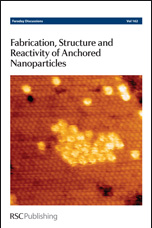The energetics of elementary surface processes relevant for CO oxidation, particularly CO and O2 adsorption, were investigated by a direct calorimetric method on model Pd nanoparticles and on the extended Pd(111) single crystal surface. The focus of this study lies on a detailed understanding of how a nanometer scale confinement of matter affects the binding strength of gaseous adsorbates. We report adsorption energies and sticking coefficients of CO and O2 measured as a function of the adsorbate surface coverage both on pristine and O-covered Pd surfaces. The reduced dimensions of the Pd substrate were found to affect the binding strength of the adsorbates in two principle ways: (i) via the change of the local adsorption environment that can result e.g. in stronger adsorbate bonding at the particle's low coordinated surface sites and (ii) via the contraction of the Pd lattice in small clusters and a concomitant weakening of chemisorptive interaction. Particularly for O2 adsorption, the change of the adsorption site from a three-fold hollow on Pd(111) to the edge site on Pd nanoparticles (∼4 nm sized on average) was found to result in a strong increase of the Pd–O bond strength. In contrast, CO adsorbs weaker on Pd nanoparticles as compared to the extended Pd(111) surface. In total, the binding energies of adsorbates on Pd and with this their surface coverages turn out to depend in a non-monotonic way on the particular structure of Pd surfaces, including the local structure of the adsorption site as well as the global properties of the small clusters arising e.g. from the lattice contraction.
This article is Open Access
 Please wait while we load your content...
Something went wrong. Try again?
Please wait while we load your content...
Something went wrong. Try again?

 Please wait while we load your content...
Please wait while we load your content...